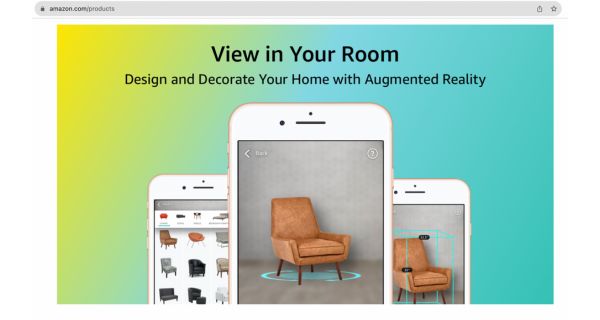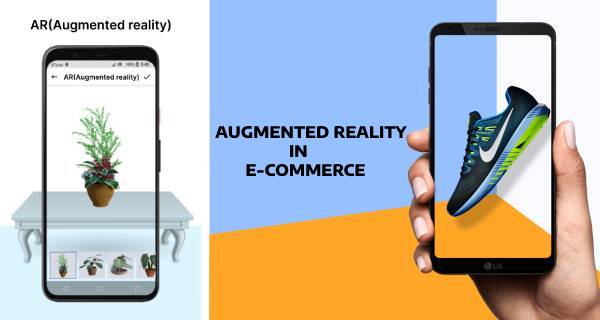E-commerce has been evolving to improve customer experience. Augmented Reality is one such development that aids eCommerce in delivering a better shopping experience. It helps keep up with changing shoppers’ expectations in the digital age. From launching the first eCommerce company in 1982 to today, companies like Amazon and Walmart leading the way, the world has seen a lot. Augmented reality in eCommerce is the beginning of the best times for eCommerce.
The past, present, and future of eCommerce
The launch of Amazon as an eCommerce marketplace for books and the introduction of the security protocol SSL in 1995 were major moves. PayPal followed this as a payment system to strengthen payment security further. Later, things like Google Adwords, Shopify, and other eCommerce stores were revolutionary. Today, Augmented Reality is fairly popular, with many brands trying to use it more and more creatively to deliver awesome shopping experiences. And with Shopify, which hosts over 325,000 businesses, when it encourages SMBs to integrate AR, it will likely increase the adoption of AR for eCommerce, significantly boosting the shopping experience.
How is Augmented reality in eCommerce making its way?
When implemented effectively, AR can be a powerful tool for eCommerce businesses across various product categories and shopping journeys, from product discovery and customized previews to convenient try-ons and seamless payments. As AR hardware and software continue advancing rapidly, integrating AR into eCommerce platforms is becoming more accessible and affordable for businesses of all sizes.
Adding AR Across the Shopper’s eCommerce Journey
While initially, AR amplified marketing and advertising content, later, things like virtual try-ons became popular as it allowed people to try and buy products with confidence from the comfort of their homes. Let us look at all the other ways AR is employed in eCommerce.
Product Discovery and Inspiration
AR for eCommerce is a massive help in creating an immersive experience to help customers choose a product. Immersive AR formats like 3D product images, holograms, and virtual showrooms help consumers discover and get inspired by products in engaging environments. For instance, cosmetics companies have launched AR “try-on” lenses on social media platforms like Snapchat for initial experimentation with beauty products where they can try the product with the filter.
Convenient Try-Ons
AR try-on capabilities are revolutionizing categories like fashion, jewelry, eyewear, and more by enabling customers to digitally try items at the convenience of their homes. The technology works by overlaying products extremely accurately on live customer images/videos based on key reference points.
Seamless Payments
Innovative AR eCommerce concepts like virtual shopping bags are coming up, allowing users to add products from different stores in a universal cart. Checkout can happen rapidly with integrated payment gateways. The advent of cryptocurrency has also aided this model of seamless payment for AR, making it more integrated with other new-age technologies.
Post-Purchase Engagement
Even after the purchase, AR opens up opportunities for continued consumer engagement via purportedly “smart” products. Many brands have started to embed customer service in a way where the customers can upload a 3D product model and ask related questions. It reduces the time customers have to spend to solve their troubles and improves the overall efficiency of customer service.
Leading eCommerce companies that leverage AR
Undoubtedly, eCommerce has become easy to get into. With solutions like Shopify stores, starting a new eCommerce business is a small entry barrier. However, starting early and doing things right gives you the edge to keep ahead of the competition. Look for augmented reality e-commerce examples to start with your own unique. Following are some of the leading eCommerce players that stand out with tech innovations, including AR:
Amazon
Amazon has adopted AR-based eCommerce into its shopping application in the form of ARview, which allows users to view and examine all the products, like furniture, in the vicinity of their homes before purchasing them.

Image Credit: Amazon
Target
Target employs the same method as Amazon by letting the users take advantage of AR by toggling the “see it in your place” feature on their platform. The ability to see the products and how they will look in your home before making a purchase is like a superpower that can help customers make the right decisions and lower return rates.
Walmart
Walmart has launched several AR-based features for its customers. These features help customers when buying something online and during a physical visit to Walmart stores. AR to help you make food and ingredient-related choices and custom experiences based on haptic feedback on 3D models are some of the few features that Walmart utilizes and plans to expand to more complicated features. Walmart even held this AR-based scavenger hunt to make the shopping experience unique for its customers.
IKEA
IKEA Place was one of the first few applications that embraced the utility AR. It allowed customers to see 3D models of its products to make a better choice. IKEA is a model example of how AR can enhance e-commerce by miles. After it was launched in 2017, it quickly became one of the most popular apps, with 8.5 million downloads.
The Home Depot
The Home Depot has also laced its application with the AR feature. It allowed its customers to see the 3D model of the product they wished to buy and see it up close and in detail. After implementing AR, Home Depot noted that conversion in product purchase increased by 2x and, in some cases, up to 3x.
Best Buy
AR features Best Buy leverage, helping the customers to try multiple products and preview them in their space before buying them.
The detailed models of various products can be used as a demo before purchasing. Best Buy also devised a campaign with Brightkite. With the help of AR, the users can access a map that helps them find the nearest Best Buy store. The campaign was unique to users. It helped them quickly reach their destination in the crowded holiday season, boosting the mood of customers and sales for the brand.
Key Benefits of Augmented Reality in eCommerce
It’s not just the visual appeal that makes AR popular among e-commerce brands. There are a lot of core features capable of turning the field upside down that make AR a perfect blend of visual and practical needs.
More Immersive Product Visualization
AR allows shoppers to visualize products in new and exciting ways, moving beyond traditional 2D images. For example, with AR-powered mobile apps such as IKEA Place, customers can preview true-to-scale 3D models of furniture or decor items in their actual living spaces. It helps them better evaluate that piece’s dimensions, aesthetics, and usage in their homes directly.
Enhanced Understanding of Products
AR also enables interaction with intricate product models to inspect design. Usually, intricate details are hard to capture with regular images and descriptions. Beauty and cosmetics brands make the most of AR-based virtual try-on tools. It allows customers to digitally apply makeup or hair colors on live selfies to understand the actual look.
Higher Engagement and Conversions
The gamified, interactive nature of AR shopping helps pique user interest and drive more engagement. The key to healthy and growth-based e-commerce is ensuring customers like the product and the experience. One survey found that 71% of shoppers would buy more products if they could experience it through AR first.
Multichannel Enablement
AR complements and supports existing multichannel capabilities for retailers with online stores and physical presence. AR features allow the ability to replicate the in-store shopping experience digitally for online shoppers. At the same time, in-store shoppers can visit the eCommerce platform for AR-enabled exploration.
Customized Solutions and Reduced Returns
One of the most significant issues of e-commerce is related to the products that the customers return. The various reasons share the same underlying cause: a lack of intimacy. Physical stores provide an all-round tactile experience. With AR, even e-commerce sites and brands can do that and reduce returns.
Implementation Tips for Small & Medium eCommerce Enterprises
If you are trying to implement AR into your business, some handy tips will help you to do that seamlessly:
1. Start Small, Test, and Learn
Launch with bite-sized AR trials linked to a few SKUs or digital campaigns rather than overhauling entire platforms. You can also seek user feedback on features and usability to fine-tune experiences over time.
2. Ensure Technical Robustness
With AR being a technically complex domain, choosing platforms and services that can provide all the necessary tools is essential. Look for ones with 3D modeling accuracy, UI/UX design, animation responsiveness, and lifelike visual quality are essential to minimize glitches.
3. Promote discovery
Different brands use different strategies to promote their brand discovery. If you want to get creative and use AR, business cards, and catalogs would be a great starting point.
4. Keep Content Fresh
Keeping the content and product-related information updated ensures customers do not get bored of it in just a few days.
5. Analyze Performance
Track metrics like AR click-through rates or qualified leads generated to quantify ROI. Build the business case for expanded AR integration.
6. Work with professionals
AR is a new field to explore; thus, getting help from a professional is a wise step to consider. While it’s true that AR can be implemented with a few tools and knowledge, consider a freelancer if the project is complex.
Augmented reality eCommerce future
AR and eCommerce will soon become inseparable. The extent of growth and development AR can see is immense, innovating the e-commerce space and benefiting in numerous ways. The future of augmented reality in eCommerce will be such that you cannot think of eCommerce without AR. Current trends are good enough for us to believe it will be an essential asset to the industry’s growth.
At PlugXR, we’ve enabled AR solutions for many medium-sized brands. We know the value they can add to the shopping experience. Platforms like ours can help you design AR for the web (WebAR), mobile (Mobile App), and headsets. You can recreate immersive VR showrooms and amplify your eCommerce store with product visualization in AR. Among tracking or AR types, today, it’s possible to create high-quality image tracking, surface tracking, face tracking, cylindrical tracking, and hand and foot tracking. These are key to integrating augmented reality in eCommerce and keeping up with in-demand try-on and try-before-buy features. Sign up to PlugXR or book a free demo to get started.

